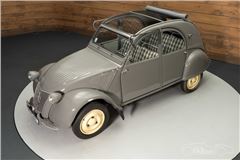Citroen 2CV and 2CV6 (1948 – 1990) Review
Citroen 2CV and 2CV6 (1948 – 1990) At A Glance
Designed before the Second World War, Citroën 2CV was conceived to motorise France's rural population. And while it might look utilitarian, underneath the Deux Chevaux was some very clever engineering. There was interconnected suspension and an unburstable air-cooled two-cylinder engine capable of driving the front wheels all day long. The simply-constructed body was considered ugly when the car was launched in 1948, but over the years, its combination of minimalist charm and French chic ended up winning the 2CV an army of fans across the globe.
During its life, the shape changed very little but there were revisions. The corrugated steel bonnet went in 1960 and over the years the interior became increasingly luxurous (relatively speaking). An uprated 435cc engine arrived, which was known as the 2CV4 from 1970. While the more powerful 602cc 2CV6 was launched in 1978. From 1982, the car got front disc brakes. But the car's best features remained: the loping ride, the comfortable seats, the ability to run flat out all day long, and the pull-back roof. All this helped maintain sales for what had become a cult car - even during its lifetime. Finally laid to rest in 1990, after a brief production run in Portugal, the Citroën 2CV joined the immortals in the automotive hall of fame - but not before a host of special editions such as the Dolly, Charleston and Beachcomber.

.jpg?width=640&height=426&rmode=crop)
.jpg?width=640&height=426&rmode=crop)
.jpg?width=640&height=426&rmode=crop)
.jpg?width=640&height=426&rmode=crop)
.jpg?width=640&height=426&rmode=crop)
.jpg?width=640&height=426&rmode=crop)


 Tin Snail is a economy motoring icon, comfortable, long-legged, limpet-like grip and a roll-back canvas roof
Tin Snail is a economy motoring icon, comfortable, long-legged, limpet-like grip and a roll-back canvas roof
 Lack of outright performance takes a little getting used to
Lack of outright performance takes a little getting used to


